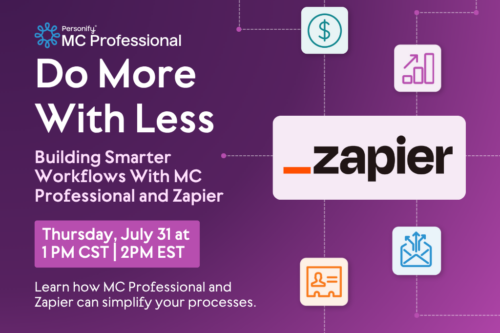Building a community around your brand is an essential part of getting your brand out to more people. One of the more effective ways to do this is creating a member ambassador program. For those who are new to this concept, a successful member ambassador program can expand your reach to new supporters and create deeper connections with current supporters of non-profits – or customers for profit-based businesses.
A member ambassador program has many benefits if it’s created properly and has well-defined key performance indicators – goals – that you want to reach.
What is a Member Ambassador Program?
Passionate customers or loyal supporters can use their voices to enhance your brand. A member ambassador program harnesses the power of your collective voices to leverage enthusiasm and influence your most dedicated fans to promote and enhance your brand. Ambassadors share their positive experiences with others and encourage them to get involved.
A member ambassador program allows you to create a more personal connection with your target audience. The ambassadors can take part in many activities, including promoting your brand on social media, representing your brand at online and offline events to engage with potential members, creating content, sharing testimonials, and providing valuable feedback on your products and services.
When you give your ambassadors the tools and resources to represent your brand, you boost marketing efforts and create loyalty among the program’s members, which, in turn, leads to increased brand awareness and business growth.
The Benefits of a Member Ambassador Program
Creating a member ambassador program has many advantages for your organization, including:
- Enhanced Brand Awareness: Because your ambassadors are enthusiastic about your brand, they’ll spread the word in their networks. Their endorsements can increase your brand’s visibility to those who you might not have reached through traditional marketing methods.
- Authentic Promotion: When your ambassadors share their personal experiences and stories, they provide authentic and relatable content that resonates with their audience. Because this type of promotion is more personal, it is often seen as more authentic than traditional marketing.
- More Community Engagement: Ambassadors can also help foster a sense of community when they actively participate in conversations. This type of involvement creates a more interactive community and encourages other members to engage with your brand.
- Cost–Effective Marketing: A member ambassador program can boost your marketing efforts in a cost-effective way. You leverage the passion of your members instead of investing in paid advertisements. You also generate more organic growth through word-of-mouth promotion.
- Valuable Feedback: Your ambassadors can also give you valuable feedback and insights on your products and services. Because they have firsthand experience with your brand, they can help you identify areas of improvement and provide innovative ideas to meet the needs of your community in a better way.
- Increased Loyalty and Retention: When you gather members in a member ambassador program, you increase their sense of loyalty to your brand. The ambassadors often feel a greater sense of ownership and pride, which means higher retention rates and long-term commitments.
- Enhanced Credibility: When you have others who can vouch for your brand, it enhances your credibility and reputation. Potential customers are more likely to trust recommendations from their friends and family who have had positive experiences with your brand than from strangers posting reviews (though reviews help significantly, too!).
- Diverse Perspectives: Finally, when you have others from various backgrounds, they can bring their own perspectives to your brand. Diverse perspectives can enrich your brand’s marketing strategies and help you reach a broader audience.
Create Your Member Ambassador Program in Just a Few Steps
You can easily create a member ambassador program with some careful planning.
1. Define Goals
Outline clear goals that you can measure for your program. Without setting clear goals, your member ambassador program could fail; thus, this is an important first step. Goals guide your strategy and help you measure progress. They should align with your overall business objectives. Goals can include:
- Increase Brand Awareness: This should be one of your primary goals. Leveraging the reach and influence of your members allows you to increase your visibility.
- Drive Sales and Conversions: Your ambassadors can help significantly drive sales and conversions by sharing exclusive promotions, product reviews, and personal testimonials. By setting specific sales targets, you can track the direct impact of your members on your bottom line.
- Enhance Community Engagement: Create an engaged community around your brand by having ambassadors start conversations and encourage participation. It will create a sense of belonging with your members, which leads to stronger community ties.
- Generate Authentic Content: Ask your ambassadors to crate and share authentic content, including photos, videos, reviews and blog posts about your brand and products or services. User-generated content is powerful social proof of how your products and services are being used.
- Collect Valuable Feedback: When your ambassadors provide firsthand feedback on your product, services and brand, it can help you identify areas of improvement, help test new ideas and ensure you meet the needs of current and potential customers.
- Strengthen Customer Loyalty: A member ambassador program can help create a deeper relationship between your brand and loyal customers. When you involve them and recognize their contributions, you create a stronger sense of loyalty and increase customer retention.
- Expanding Your Reach on Social Media: Leverage your ambassadors’ social media presence to extend your reach beyond what your typical marketing strategy would reach. Have them use Instagram, X, LinkedIn, and Facebook to reach wider audiences.
- Boosting Event Participation: Ask ambassadors to act as representatives at events to help attract attendees and engage with participants. Events can include trade shows, webinars, community gatherings and even fundraisers for a favorite charity – or, if you are a non-profit, for your own charity.
- Encouraging Product Adoption: Ambassadors can help generate excitement for new product or service releases. Their firsthand experience can help persuade others to try new products and services – and share their feedback.
- Increasing Membership or Subscription Rates: If your business model involves subscriptions or memberships, your ambassadors can help drive signups by sharing positive experiences, offering referral incentives and highlighting the benefit of joining your community.
2. Identify Ambassadors
Determine who your ambassadors will be – they should be passionate about your brand and have a strong influence in the community. Choose members who are already active and engaged, as they are more likely to be effective members.
3. Develop Recruitment Strategy
Create a member recruitment strategy. First, you must identify ideal ambassadors. You want people who have a passion for your brand and who have a strong social media presence. They should be willing to actively participate in community events and social media channels. Ambassadors should also have a positive reputation and align with your brand values.
As part of your recruitment strategy, create a compelling value proposition, develop an outreach plan and create an engaging application process, such as using video or surveys. Once you have some applications, you’ll need to screen ambassadors and select those who would be a good fit for your brand.
Have a welcome package ready for each new ambassador that includes branded materials, an ambassador handbook, and exclusive products. Include training sessions and set up an introduction to the community.
4. Create a Training Program
Develop a training program to give your ambassadors the skills they need. Include information about your brand and products, brand history, social media best practices, key messages, and guidelines for representing your brand.
5. Provide Resources and Tools
Supply your members with tools and resources to promote your brand, including:
- Ambassador Handbook: This should be a comprehensive guide that outlines your program’s expectations, objectives, roles and responsibilities. Include your brand history, promotional guidelines, key messages, dos and don’ts.
- Training Materials: Online training materials or webinars that cover brand knowledge, effective communication techniques and social media best practices.
- Branded Assets: Include high-quality images, logos and videos for your ambassadors to use in their content and social media posts.
- Content Calendar: Include key dates, campaign timelines, suggested content ideas and other content information to keep ambassadors aligned with your brand and on schedule. Regularly update your content calendar.
- Social Media Management Tools: Provide tools such as Sprout Social, Hootsuite and Biffer to help your ambassadors schedule and manage social media posts. Also, include analytics tools so they can track engagement and performance.
- Communication Platforms: Provide a dedicated communication channel, such as a private Facebook group, Slack or Discord, for real-time interaction and support. Regular newsletters and email updates also keep ambassadors informed and engaged.
- Feedback Mechanisms: Create surveys and feedback forms and request regular check-ins to gather suggestions and insights from your ambassadors.
- Incentive and Rewards System: Outline rewards and your recognition system, such as points, badges, and other incentives. You can also include exclusive discounts and early access to products and special events for rewards.
- Performance Tracking Tools: Provide performance tracking tools, such as referral codes, sales conversions and engagement metrics for your ambassadors.
- Event Participation Kits: Create event participation kits that include flyers, banners, brochures and promotional items for ambassadors who attend events on your behalf. Include guidelines for representing your brand at various events.
- Collaboration Tools: Use tools such as Dropbox and Google Drive to make sharing and collaboration easier.
- Recognition and Awards: Create awards, certificates and public recognition programs to acknowledge your top-performing ambassadors. You can highlight standout ambassadors monthly or quarterly.
6. Set Expectations and Guidelines
Ensure your expectations are clear so there is consistency in your messaging from the ambassadors. Provide them with a detailed handbook that outlines their roles, responsibilities, and dos and don’ts in the program.
7. Develop an Incentive Program
Create an incentive program to reward the ambassadors. The incentives should align with your members’ interests. You could include:
- Discounts
- Exclusive perks
- Recognition
- Opportunities for professional and personal growth
8. Maintain Regular Communication
Always communicate with your ambassadors, including giving them regular updates. Check in with them often and hold feedback sessions so you can address concerns and challenges. You can communicate via webinars, emails, and social media groups.
9. Gather Feedback and Make Improvements
So you can understand your ambassadors’ experiences and identify areas for improvement, collect feedback from them on a regular basis.
10. Measure and Report Success
Measure your key metrics to track the performance of your ambassadors. Key metrics include:
- Engagement rates
- Reach
- Conversions
- Feedback quality
Key Takeaways
- A member ambassador program can leverage passionate members to promote your brand through authentic engagement.
- Establish measurable key performance indicators.
- Identify ideal ambassadors who will participate in the program.
- Develop a strong recruitment strategy.
- Provide comprehensive training for new ambassadors so everyone stays on message for your brand.
- Offer resources, support and benefits to your ambassadors to keep them engaged.
- Create an incentive program to help keep ambassadors engaged.
- Regular communication is an imperative part of a successful member ambassador program.
Start Your Member Ambassador Program Today!
With these components of building a successful member ambassador program, you are now ready to take action and get started. Creating a member ambassador program can help your most enthusiastic members become powerful advocates for your brand and drive growth.
Take the first step by defining your goals, then identify potential ambassadors and create a recruitment strategy. Add training and resources, and you’re ready to launch your program and start communicating through various channels to grow your community.
Don’t wait to create a powerful strategy for your member ambassador program. Launch it today and watch your brand’s reach grow! Join the ranks of successful brands and discover how an AMS software can help you achieve your goals and build meaningful relationships with your members.
















